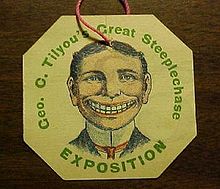
The Steeplechase Face was the mascot of the historic Steeplechase Park, the first[1] of three amusement parks in Coney Island, Brooklyn, New York.[2] It remains a nostalgic symbol of Coney Island and of amusement areas influenced by it.[3] It features a man with a wide, exaggerated smile which sometimes bears as many as 44 visible teeth. The image conveys simple fun,[4] but was also observed by cultural critics to have an undercurrent of Victorian-era repressed sexuality.[5]
It was also known as the Funny Face after the park's slogan "Steeplechase - Funny Place" or as Tillie, after the park's founder George C. Tilyou. It has also sometimes been named Steeplechase Jack. The mascot represented the area's wholesomeness and neoclassical architecture combined with its veneer of hidden sexuality.[3][6][5] Though the park was a "family-friendly" area, it was nearby the "freer sexual expression of the dance halls, beaches, and boardwalk."[7]
The "Funny Face" logo has become an iconic symbol of Coney Island.[3]
- ^ Ryan, Hugh (2019-03-05). When Brooklyn Was Queer: A History. St. Martin's Publishing Group. ISBN 978-1-250-16992-1.
- ^ "George Tilyou's Steeplechase | Smithsonian American Art Museum". americanart.si.edu. Retrieved 2022-12-28.
- ^ a b c Cross, G.S. (2005). The Playful Crowd: Pleasure Places in the Twentieth Century. Columbia University Press. pp. 39–40. ISBN 978-0-231-12724-0.
- ^ ""The Face Of Steeplechase" Opening May 24 at the Coney Island History Project". Coney Island History Project. 2014-05-19. Retrieved 2021-07-10.
- ^ a b ""The Face of Steeplechase" at the Coney Island History Project". Brooklyn Paper. May 30, 2014. Retrieved July 15, 2019.
- ^ Goldfield, David R. (2006). Encyclopedia of American urban history. Thousand Oaks: Sage Publications. p. 185. ISBN 978-1-4522-6553-7. OCLC 162105753.
- ^ Ryan, Hugh (2019-03-05). When Brooklyn Was Queer: A History. St. Martin's Publishing Group. ISBN 978-1-250-16992-1.
